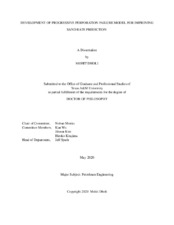| dc.contributor.advisor | Morita, Nobuo | |
| dc.creator | Dholi, Mohit | |
| dc.date.accessioned | 2020-12-17T15:13:21Z | |
| dc.date.available | 2020-12-17T15:13:21Z | |
| dc.date.created | 2020-05 | |
| dc.date.issued | 2020-03-12 | |
| dc.date.submitted | May 2020 | |
| dc.identifier.uri | https://hdl.handle.net/1969.1/191616 | |
| dc.description.abstract | Formation sand production has been a recurring problem for the oil and gas industry since the advent of the hydrocarbon exploration and extraction. The effects of sand production are adverse in nature and are two folds; causing decrease in well productivity (due to sand control measures) and erosion of equipments. High strength rocks rarely disintegrate and produce sand, even if they do it is very late in the life of the well. Soft and weak rocks may produce sand very early in the life of the well and thus will need sand control measures. Intermediate strength rocks need to be evaluated for their sand production potential.
As a producer, the endeavor is to extend hydrocarbon production without employing any sand control measures. A robust estimate of onset and the rate of sand production will provide the necessary information to regulate the operation schedule such that no or little sand production occurs throughout the life of the well. The same analysis will also furnish the operator with appropriate information on completions and sand control techniques to employ in case of excessive sand production predictions. In this study, a coupled finite element numerical sand rate model is developed which is calibrated with poly-axial sand production experiments. The effect of stress anisotropy on the onset of sand production and the rates of sand production is evaluated. Sand production is a moving boundary problem hence adaptive meshing is employed. It is found that increase in axial and lateral anisotropy would make the rock more susceptible to sand production. The onset is found to be earlier in these cases. Also, the sand rates are higher with higher anisotropies. A field study is also presented which reaffirms the need of sand rate calculation. The numerical model is made in such a way that different completion schemes can be tried and tested for sand rate results. | en |
| dc.format.mimetype | application/pdf | |
| dc.language.iso | en | |
| dc.subject | Sand Production | en |
| dc.subject | FEM | en |
| dc.subject | Finite Element Method | en |
| dc.subject | Sand Rate Model | en |
| dc.subject | Sand erosion | en |
| dc.subject | Critical plastic strain failure criterion | en |
| dc.subject | Drucker-Prager yield criterion | en |
| dc.subject | poly-axial volumetric sand production experiments | en |
| dc.subject | field study | en |
| dc.subject | perforation pattern | en |
| dc.subject | remeshing | en |
| dc.subject | matlab | en |
| dc.subject | completions | en |
| dc.subject | production engineering | en |
| dc.subject | geomechanics | en |
| dc.subject | sequential coupling | en |
| dc.subject | fixed strain method | en |
| dc.subject | fluid flow | en |
| dc.subject | perforation cavity failure | en |
| dc.title | Development of Progressive Perforation Failure Model for Improving Sand Rate Prediction | en |
| dc.type | Thesis | en |
| thesis.degree.department | Petroleum Engineering | en |
| thesis.degree.discipline | Petroleum Engineering | en |
| thesis.degree.grantor | Texas A&M University | en |
| thesis.degree.name | Doctor of Philosophy | en |
| thesis.degree.level | Doctoral | en |
| dc.contributor.committeeMember | Wu, Kan | |
| dc.contributor.committeeMember | Kim, Jihoon | |
| dc.contributor.committeeMember | Kitajima, Hiroko | |
| dc.type.material | text | en |
| dc.date.updated | 2020-12-17T15:13:21Z | |
| local.etdauthor.orcid | 0000-0001-6506-4249 | |


